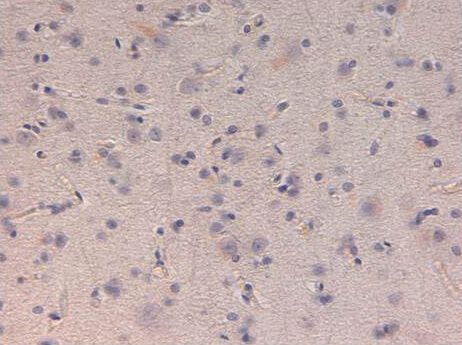Anti-Kinesin-1 (Rabbit) Antibody
Kinesin-1 Antibody
- SPECIFICATION
- CITATIONS
- PROTOCOLS
- BACKGROUND

| Host | Rabbit |
|---|---|
| Conjugate | Unconjugated |
| Target Species | Human |
| Reactivity | Human |
| Clonality | Polyclonal |
Application
| WB, IHC, E, I, LCI |
| Application Note | Kinesin-1 antibody has been tested for use in western blot, and immunohistochemistry. For western blots expect a band of approximately 72 kDa in size corresponding to truncated kinesin-1 protein. Specific conditions for reactivity should be optimized by the end user. |
| Physical State | Liquid (sterile filtered) |
| Buffer | 0.02 M Potassium Phosphate, 0.15 M Sodium Chloride, pH 7.2 |
| Immunogen | Anti-Kinesin-1 was prepared from whole rabbit serum produced by repeated immunizations with a truncated kinesin-1 construct expressed in E. coli corresponding to human kinsesin-1 protein. |
| Preservative | 0.01% (w/v) Sodium Azide |
| Gene ID | 3799 |
|---|---|
| Other Names | 3799 |
| Purity | Anti-Kinesin-1 is directed against the human kinesin-1 protein. The product was prepared from monospecific antiserum by delipidation and defibrination. A BLAST analysis was used to suggest reactivity with human. Cross-reactivity with kinesin 1 from other sources have not been determined. |
| Storage Condition | Store vial at -20° C prior to opening. Aliquot contents and freeze at -20° C or below for extended storage. Avoid cycles of freezing and thawing. Centrifuge product if not completely clear after standing at room temperature. This product is stable for several weeks at 4° C as an undiluted liquid. Dilute only prior to immediate use. |
| Precautions Note | This product is for research use only and is not intended for therapeutic or diagnostic applications. |
| Name | KIF5B (HGNC:6324) |
|---|---|
| Synonyms | KNS, KNS1 |
| Function | Microtubule-dependent motor required for normal distribution of mitochondria and lysosomes. Can induce formation of neurite-like membrane protrusions in non-neuronal cells in a ZFYVE27-dependent manner (By similarity). Regulates centrosome and nuclear positioning during mitotic entry. During the G2 phase of the cell cycle in a BICD2- dependent manner, antagonizes dynein function and drives the separation of nuclei and centrosomes (PubMed:20386726). Required for anterograde axonal transportation of MAPK8IP3/JIP3 which is essential for MAPK8IP3/JIP3 function in axon elongation (By similarity). Through binding with PLEKHM2 and ARL8B, directs lysosome movement toward microtubule plus ends (Probable). Involved in NK cell-mediated cytotoxicity. Drives the polarization of cytolytic granules and microtubule-organizing centers (MTOCs) toward the immune synapse between effector NK lymphocytes and target cells (PubMed:24088571). |
| Cellular Location | Cytoplasm, cytoskeleton {ECO:0000250|UniProtKB:Q2PQA9}. Cytolytic granule membrane. Lysosome membrane; Peripheral membrane protein; Cytoplasmic side Note=Uniformly distributed between soma and neurites in hippocampal neurons. {ECO:0000250|UniProtKB:Q2PQA9} |

Thousands of laboratories across the world have published research that depended on the performance of antibodies from Abcepta to advance their research. Check out links to articles that cite our products in major peer-reviewed journals, organized by research category.
info@abcepta.com, and receive a free "I Love Antibodies" mug.
Provided below are standard protocols that you may find useful for product applications.
Background
Intracellular transport is critical to cellular functions and the maintenance of its integrity (membrane renewal, vesicles trafficking, cell division, mRNA transport, etc.). Among the molecular motors that are involved in intracellular transport, three large superfamilies have been identified and well characterized these last decades – kinesins, dyneins and myosins. Kinesins, also known as KIFs, are microtubule-dependent molecular motors that use ATP as chemical fuel to transport cargo along the microtubule network. Indeed, five major kinesin families were initially described but there are as many as 45 mammalian kinesin genes to date. In most kinesins, the motor domain is found at the N-terminus (N-type). N-type kinesins are (+) end-directed motors, i.e. they transport cargo towards the (+) end of the microtubule. In the neuronal axon, synaptic vesicle precursors, mitochondria and protein complexes are transported bi-directionally. While retrograde transport is powered by dyneins, anterograde transport is essentially powered by kinesins. Deciphering the regulation and functions of kinesins constitutes a major challenge and will broaden our understanding of molecular motors implications in intracellular transport.
If you have used an Abcepta product and would like to share how it has performed, please click on the "Submit Review" button and provide the requested information. Our staff will examine and post your review and contact you if needed.
If you have any additional inquiries please email technical services at tech@abcepta.com.













 Foundational characteristics of cancer include proliferation, angiogenesis, migration, evasion of apoptosis, and cellular immortality. Find key markers for these cellular processes and antibodies to detect them.
Foundational characteristics of cancer include proliferation, angiogenesis, migration, evasion of apoptosis, and cellular immortality. Find key markers for these cellular processes and antibodies to detect them. The SUMOplot™ Analysis Program predicts and scores sumoylation sites in your protein. SUMOylation is a post-translational modification involved in various cellular processes, such as nuclear-cytosolic transport, transcriptional regulation, apoptosis, protein stability, response to stress, and progression through the cell cycle.
The SUMOplot™ Analysis Program predicts and scores sumoylation sites in your protein. SUMOylation is a post-translational modification involved in various cellular processes, such as nuclear-cytosolic transport, transcriptional regulation, apoptosis, protein stability, response to stress, and progression through the cell cycle. The Autophagy Receptor Motif Plotter predicts and scores autophagy receptor binding sites in your protein. Identifying proteins connected to this pathway is critical to understanding the role of autophagy in physiological as well as pathological processes such as development, differentiation, neurodegenerative diseases, stress, infection, and cancer.
The Autophagy Receptor Motif Plotter predicts and scores autophagy receptor binding sites in your protein. Identifying proteins connected to this pathway is critical to understanding the role of autophagy in physiological as well as pathological processes such as development, differentiation, neurodegenerative diseases, stress, infection, and cancer.


